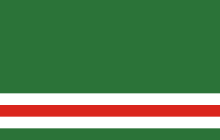Chechen Republic of Ichkeria
As Chechen Republic of Ichkeria ( Russian Чеченская Республика Ичкерия , Chechen Нохчийн Республика Нохчийчоь ) described himself in 1991 that of Chechen separatists proclaimed, not internationally recognized, independent state, which from its crackdown by Russian troops in 1999 an active from the underground, militant rival government to the Chechen Republic of the Russian Federation . Since the last president of the separatists announced in 2007 the absorption of the Ichker republic into the Caucasus emirate he proclaimed, the previous name has been continued by a smaller group of Chechens as the name for their government-in-exile .
history
On November 2, 1991, shortly before the collapse of the Soviet Union on December 25, the newly elected parliament of the Autonomous Soviet Socialist Republic (ASSR) Checheno-Ingushetia , which was previously bound to the Russian SFSR of the Soviet Union , declared itself independent and appointed election winner Jokhar Dudayev as the first President of the proclaimed Chechen Republic of Ichkeria. Encouraged by the reform policy of the President of the Soviet Union, Mikhail Gorbachev , and the independence movements in the Baltic States , the Vainach Democratic Party was founded in May 1990, the first political party with the declared goal of Chechen independence.
The declaration of independence took place on the legal basis of Act No. 1457-I of the Soviet Union, signed by Gorbachev in April 1990, on the delimitation of powers between the USSR and the subjects of the federation , which raised the Autonomous Soviet Republics to the status of "Soviet socialist states" the aspirations for independence of the 15 union republics to which the autonomous republics were previously subordinate should be weakened. However, this law, and with it Chechnya’s independence, was subsequently not recognized by Russia. The politically independent counter-government of Chechnya did not receive any significant international recognition. The only exceptions were Georgia during the reign of Sviad Gamsakhurdia between 1991 and 1992 and the Islamic emirate of Afghanistan (the Taliban government was not recognized by the Ichkeria).
After the end of the First Chechen War , Boris Yeltsin , President of the Russian Federation, and Aslan Maskhadov , President of the Ichker Republic, signed a peace treaty on May 12, 1997 that did not confirm the country's statehood, but de facto the rebel government as negotiating partner accepted. The attack by Chechen Islamists under Shamil Basayev in 1999 on the neighboring republic of Dagestan broke the fragile peace.
In October 1999 the existence of the de facto independent state came to an end with the invasion of Russian troops in the Second Chechen War . However, the rebel movement in Chechnya still stuck to the term Chechen Republic of Ichkeria - in contrast to the Moscow-backed government under Akhmad Kadyrov, which only used the term Chechen Republic. The counter-president was Aslan Maskhadov, who was killed by Russian special forces in Chechnya in 2005. His successor, Sheikh Abdul Halim Sadulayev, allied himself with jihadist groups throughout the North Caucasus and joined the Caucasian Front. He was killed by Russian forces during an operation in his hometown of Argun . His successor was initially the rebel field commander Doku Umarow . When the Caucasus emirate was proclaimed in October 2007, the Ichkeria Republic was considered dissolved.
Sections of the Chechen separatist movement that disagreed with the proclamation of the Caucasus emirate broke away from Umarov and continued to call their exile movement the “Chechen Republic of Ichkeria”. Its leader is Akhmed Sakayev , who has lived in Great Britain since 2001 .
President
- Jokhar Dudayev (1991-1996)
- Selimchan Jandarbijew (1996–1997, acting)
- Aslan Maskhadov (1997-2005)
- Abdul Halim Sadulayev (2005-2006)
- Documentary Umarow (2006-2007)
- Achmed Chalidowitsch Sakajew (2007 – ongoing)
Name "Itschkerien"
The name of the country, Itschkerien, used as a synonym for Chechnya, goes back to the Turkic name “Itsch-Geri”, which originally referred to the southern mountain region of today's Chechnya and which later preceded “Chechna”, which was later coined as the name for the northern plain.
See also
literature
- Anne Le Huérou, Aude Merlin, Amandine Regamey, and Elisabeth Sieca-Kozlowski (eds.): Chechnya at War and Beyond. Routledge, London 2014, ISBN 9781317756163 (English)
Web links
- Chechen Republic of Ichkeria, in the database mapping Militant Organizations of Stanford University (English)
Individual evidence
- ^ Robert W. Schaefer: The Insurgency in Chechnya and the North Caucasus: From Gazavat to Jihad. ABC-Clio, Santa Barbara, 2010, pp. 108–116 (English)
- ^ Schaefer: The Insurgency in Chechnya and the North Caucasus. P. 108 f.
- ↑ Anja Schlage: The distribution of state power between the Russian Federation and its subjects: Representation of federalism in Russia from a German perspective. LIT, Münster 2011, p. 76 ( on Google Books )
- ^ Babak Rezvani: Ethno-territorial conflict and coexistence in the caucasus, Central Asia and Fereydan. Amsterdam University Press, 2014, p. 238 ( on Google Books )
- ↑ R. von Erckert: The Caucasus and its peoples. Reprint of the original from 1888, Salzwasser, Paderborn 2011, ISBN 9783861959984 , pp. 130 and 132 (on Google Books )

